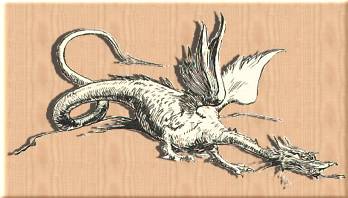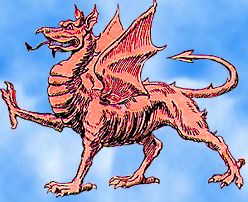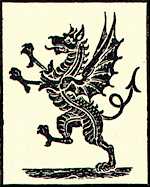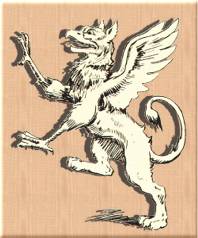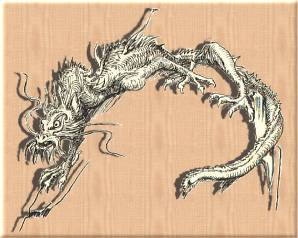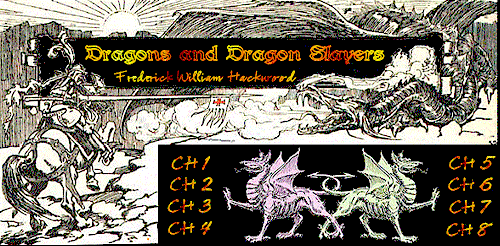
![]()
CHAPTER FIVE
~ Heraldic
Dragons ~
![]()
|
IN heraldry the dragon, and the still stranger variants of this fabulous beast, as the griffin, the wyvern, and the cockatrice, are common charges found on the shields of a number of our old landed families. The more fanciful variants are the products of the fertile imaginations of Eastern warriors and copied from them by the victorious Crusaders as mementoes of their expedition. The heraldic dragon is a winged monster, covered with scales, and having four legs ; its tail and tongue are armed with a conventional sting. The griffin is an animal the head, shoulders, wings, and fore-feet of which resemble an eagle, the body, hind-legs, and tail being formed like a lion. The male griffin is distinguished by being destitute of wings, but having two straight horns rising from its forehead and rays of gold issuing from various parts of the body. The cockatrice has the head, body, wings, and feet of a cock (scales being substituted for feathers) and the tail of a dragon.
usually has but two. The cockatrice is mentioned several times in the Old Testament, as if it were a real creature to be found in nature. Here is the ancient legend of its origin : When the cock is past seven years old an egg grows within him, whereat he greatly wonders. He seeks privately a warm place, on a dunghill or in a stable, and scratches a hole for a nest, to which he goes ten times daily. A toad privily watches him, and examines the nest every time the cock leaves it, to see if the egg yet be laid. When the toad finds the egg, he rejoices much, and at length hatches it, producing an animal with the head, neck, and breast of a cock, and from thence downwards the body of a serpent. And this is a cockatrice. These heraldic dragons and other armorial monstrosities are painted in various colours, and hence it is we come across green dragons or golden dragons on public-house signs, which are often copied from the armorial shields of the neighbouring landowners. It is worthy of note that in the early history of this country the dragon as a warlike symbol or battle-flag, was used by both the Britons and the Angles. The dragon plays an important part in the legendary history of the ancient Britons. In the fables and pretended prophecies of Merlin, their great Prince of Enchanters, he is described as red in colour, and so differing from the Saxon dragon, which was white. King Arthur wore a dragon crest on his helmet. On the other hand, in the mythology of our Norse forefathers Thor son of Woden, the god of War, was numbered among the valiant dragon slayers. In the early days of the Saxon Heptarchy the dragon was used, in varying tinctures, by several of the kingdoms : Mercia displayed a golden dragon, Dyved a green dragon, Sussex (Counts of the Shore) a black dragon ; and there were other variants besides. The red and white dragons of the prophecies of Merlin were apparently intended to represent or personify the British and the Saxon races. When Owen Glendower, the last native Prince of Wales, joined Hotspur's rebellion, he called himself by the name of "Dragon," thinking to fulfil propitiously one of Merlin's prophecies concerning the ultimate triumph of the British dragon. Yet in the winter of 1401 he was forced to retreat from Carnarvon under the banner of a golden dragon on a white ground.
In the language of the ancient Britons, it is thought by some, the word "dragon" meant a chief or ruler ; and so when a British knight slew a chief he slew a dragon ; and it may be that in the course of time the military title got confounded with the fabulous monster. With the prefix "pen," signifying head, the title Pendragon (head chief) was conferred on several British rulers in times of great national danger, when the bearer was invested with the most absolute and over-riding powers. The title of Pendragon was borne by Uter, and after him by his more famous son King Arthur, both of whom were, in turn, appointed to repel the Saxon invaders. Geoffrey of Monmouth, the old chronicler, relates that when Aurelius, the British king, was poisoned by Ambron, during the invasion of Pascentius, son of Vortigern, there appeared a star at Winchester of a wonderful magnitude and brightness, darting forth a ray at the end of which was a globe of fire in the form of a dragon. Out of the dragon's mouth issued forth two diverging rays, one of which extended to Gaul in the east and the other to Ireland in the west. Uter ordered two golden dragons to be made, one of which he presented to Winchester, and the other he carried with him as the royal standard, whence he received the name of Uter Pendragon - "wonderful supreme leader." According to the heralds of a later period the shield of this great British hero bore on a silver ground a green wyvern with red beak and claws. The use of the red dragon (y ddraig coch) as the armorial bearing or standard of the Britons is a subject of some heraldic interest. Whether the device was a relic of the widely spread worship of the serpent or had a more local origin is, and must always remain, a subject for speculation and much ingenious argument. The device of the red dragon has made some memorable appearances in English history. Harold displayed the dragon standard at Senlac. The early Plantagenet kings had the same - an inflated thing which caught the wind, rolled its eyes, and assumed the ferocity of a living monster. At the battle of Lewes, in 1264, the flag of Henry III and of his brother Richard, King of the Romans, was emblazoned with this device, probably in compliment to the Cornish Britons, as Richard was also Earl of Cornwall. The royal instructions for the making of this standard have been preserved. It was ordered "to be made with a dragon in the manner of a banner, of a certain red silk embroidered with gold ; its tongue like a flaming fire must always seem to be moving ; its eyes must be made of sapphire or of some other stone suitable for that purpose." The mandate for this (or a very similar) flag was issued twenty years previously by the king to Edward Fitz Odo, who was to place it in the church of St. Peter, at Westminster, June 17, 1244. It was a standard of this description which was captured in the battle of 1264, when the king and his brother were both taken prisoners by Simon de Montfort. At the battle of Crécy, in 1346, the King of France having displayed the holy standard of that nation, the "Oriflamme," it indicate his intention of refusing quarter to his enemies, our king, Edward III, unfolded his banner of "the Burning Dragon" to portend like intention. Consequently a vast number of men were slain and not prisoner was taken. Henry Tudor, Earl of Richmond, claiming descent from the ancient Kings of Wales, adopted the red dragon for the device of his standard at Bosworth Field. When he became king, as Henry VII, he altered the designation of one of the Pursuivants at Arms (which his rival, Richard III, had instituted after his own bearings as Blanch Sanglier, or White Boar) to Rouge Dragon ; and so called that officer remains to this day, as one of the four state messengers at grand court ceremonies. The red dragon that became one of the supporters of the royal arms ; and Shakespeare's frequent allusion to the monster, as hidden compliments to Queen Elizabeth, may have been noted. But on the accession of James I, and the union of England with Scotland, the unicorn, one of the supporters of the arms of Scotland, was substituted. So it came about that in the royal coat-of-arms of Great Britain no emblem representative of Wales was left. This heraldic omission is unfortunate, as the red dragon has been recognised by Welshmen as their national device since the times of the Arthurian cycle ; with its Welsh motto, "Y ddraig goch a ddry gychwyn" ("The red dragon marches on"), it is the territorial badge of the Welsh regiments. As to the exact way in which the dragon should be emblazoned there appears to be some doubt. It has commonly assumed the rampant attitude ; but the correct way to represent it is now declared to be "on a green mound a red dragon passant" - i.e. walking with one fore-leg raised. The dragon enters into the armorial bearings of a large number of ancient territorial
families of Dragonetti and Del Drago both bear dragons. Similarly in the British Peerage and Baronetage interesting examples may be found. The Drake family bear the same arms - wrongfully assumed by the famous Sir Francis - as the Italian noble family of Del Drago. The griffin, we have noticed, is supposed to be the offspring of the lion and the eagle.
learning and credulity in 1646, entitled Vulgar Errors, gravely states that the griffin is emblematical of watchfulness, courage, and rapidity of execution. These mythical guardians of the gold-mines were constantly at war with a one-eyed people of Scythia, called Arimaspians, who adorned their hair with gold. To this fable we find allusion in Milton's Paradise Lost : "As
when a gryphon, through the wilderness... In the legend of Prester John we read of a pestilence ceasing when one Astolpho arrives on a flying griffin and chases the harpies away. The supporters of the City of London's arms are griffins. When Temple Bar, which indicated the boundary line between the two cities of London and Westminster, was removed in 1878, to mark the site a memorial was erected in the form of a pedestal, having on its sides appropriate sculptured panels, and surmounted by a bronze griffin supporting a shield bearing the city arms. At one time the city supporters were lions, but these seem to have been supplanted by the griffins of Wales as a bit of flattery to Henry VII, the first monarch of the Welsh line of Tudor. The wyvern constituted the ancient crest of the town of Leicester ; it is now well known as the badge of the Midland Railway, which had its beginnings in that place. A very ornate representation of it appears on the helmet of Thomas Plantagenet, Earl of Lancaster, tempo Edward III - a significant fact which has not escaped the notice of the eminent Midland herald, Mr. Alfred Rodway, who recalls that though his shield shows the arms of Lancaster, his crest discloses that he was also the Earl of Leicester. The cockatrice is so called because it was commonly supposed to be produced from a cock's egg hatched by a serpent. According to legend the very look of this monster was supposed instant death. In Shakespeare's Twelfth Night appears the allusion, "They will kill one another by the look." The prophet Isaiah says, "The weaned child shall put his hand on the cockatrice' den" ; implying that the most noxious of beasts should not be able to hurt the feeblest of God's creatures. Figuratively the cockatrice stands for an insidious, treacherous individual, bent on mischief. In consequence of the crest with which the head is crowned the creature is sometimes called a basilisk ; from the Greek word basiliskos, meaning "a little king." The basilisk is, rightly, the king of serpents and dragons ; it also is supposed to have the power of looking anyone dead on whom it fixes its eyes. Hence the poet Dryden makes Clytus say to Alexander, "Nay, frown not so ; you cannot look me dead." The attribution of the kingly rank to this monster arises from the creature's head being crowned with a mitre-shaped crest. These two fabulous creatures, the cockatrice and the basilisk, are virtually the same in all their attributes, but the latter is unknown in heraldry. Of the swift death-dealing glance of the basilisk the ancient philosopher, Aristotle, once proposed to take military advantage by suggesting to Alexander that the deadly creature should be lifted on to the wall of a besieged city and strike all the inhabitants dead. Not only was this most deadly asp fatal through its glance, but when it hissed at an enemy it breathed forth a poison which contained every plague to which man was subject. In natural history there is a genus of lizards called basilisks - quite innocent of all the deadly powers attributed to the fabled monster. Reptiles in real life, and to some extent the batrachians, have always excited as much curiosity as aversion, and the strangest beliefs have been cherished in regard to some of them. Even the familiar toad has not escaped a sort of superstitious veneration for qualities it never possessed. It was once a common belief, mentioned in Shakespeare, that "the toad, ugly and venomous, wears yet a precious jewel in its head." The toad is not venomous, nor yet is it a creature set with precious gems. An old writer, of the year 1569, gravely informs us that "there is found in the heads of old and great toads a stone they call borax or stelon, which being used as rings gives forewarning against venom." Another ancient scribe says, "These stones always bear a figure resembling a toad on their surface." Yet another equally credulous writer states that these toad-stones (crepaudiae) are a sure remedy against the bites of rats and spiders ; and that they sweat and change colour when brought into close proximity with poison. The humble toad, too, appears in ancient legend. The banner of the old Kings of France from the days of Clovis was a blue ground on which were emblazoned three toads (botes they were called in old French), but once when the banner was advanced against an army of heretics the three toads were miraculously changed into three lilies. And truly, if one looks at the old French standard of the white lilies on an azure field, it is not difficult to see in the conventional form of the fleur-de-lis an outline not unlike that of a flattened, sprawling toad. Then there is the salamander, a small and comparatively harmless lizard found in various parts of Europe, credited with being incombustible, and able to live in fire. Francis I, of France, adopted as his badge a salamander in the midst of flames, with the motto, "Nutrisco et extinguo" ("I nourish and extinguish"). Asbestos, now used largely in gas fires because it will get red hot and not burn away, is a mineral of strangely fibrous texture, which has sometimes been called "salamader's wool." That there existed a huge winged lizard, or flying serpent, who was regarded as the enemy of mankind, seems to have been a universal belief from the very beginning of things. The fable of this monster has been welded on to history in all manner of ways from the remotest antiquity. Generally there was only one enemy capable of overcoming it - the eagle, which never failed to attack, to vanquish, and then devour it. Travellers' tales often gave corroboration to the belief, Winged serpents inhabited Arabia, said Herodotus. An old Dutch voyager found fearsome flying snakes in Java. Other ancient geographers located them in India. And so on. Dragons are as widely distributed as the belief in them.
embroidered on the emperor's official robes and blazoned on his banners. The figure is depicted stretched at full length, or curled up with two legs pointing forwards and two backwards ; sometimes it holds a pearl in one hand, and is surrounded by clouds and fire. Here is found no confusion between dragon and serpent ; in Chinese drawings a clear distinction is always made. The Japanese dragon, equally ubiquitous in the art of that country, is probably derived from the Chinese dragon, but invariably it is represented with three claws, whereas its prototype has either five or four. Japanese literature is full of dragon stories ; while the decorative art of the country, especially in bronzes and carvings, teems with fantastical figures of the ever-popular dragon device. There is also a Corean dragon which has apparently been borrowed from the Chinese. A very learned monograph on The Dragon in China and Japan appeared recently from the pen of N. De Vissier (Amsterdam, 1913), in which we are informed that Buddha is worshipped by "eight classes" of beings, ranging from men to "nagas," and including goblins, demons, giants, ghosts, the inhabitants of hell, and lastly by the said nagas - an Oriental name which seems to cover the identity of that universal character, the dragon. The nagas are described as four-legged dragons who dwell in the Loka (world) under the Trikuta Rocks that support Meru. They are supposed to be divided into castes ; and when insulted express their resentment by sending drought, bad crops, disease, pestilence, and other disasters upon mankind. There is an immense amount of Buddhist lore concerning nagas, and it is interesting to note that "the eight dragon kings" were devout and reverent worshippers of Buddha to whom a Shinto temple was dedicated. |
